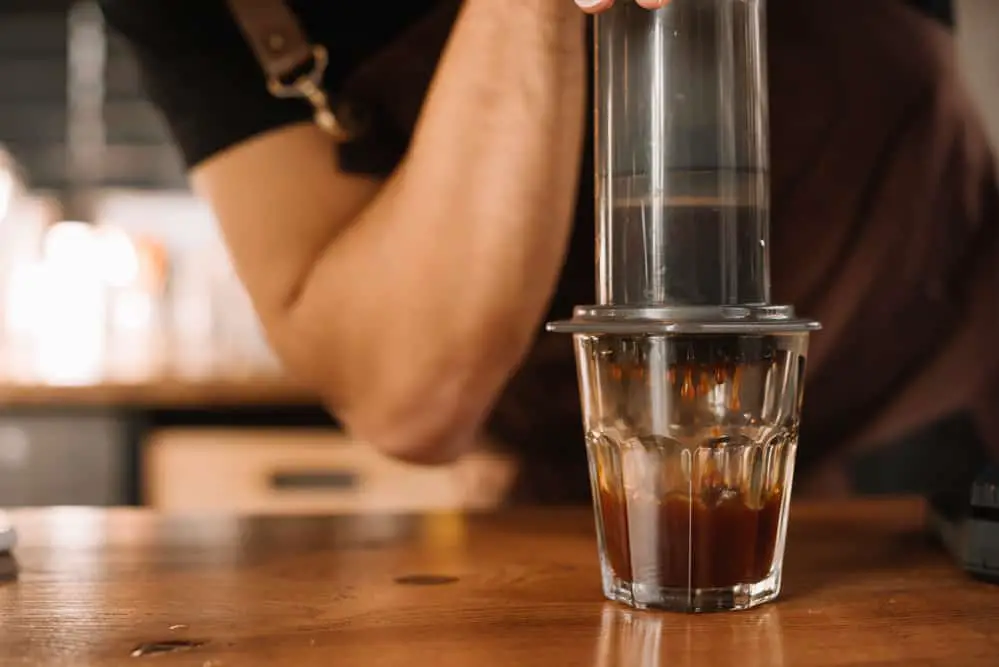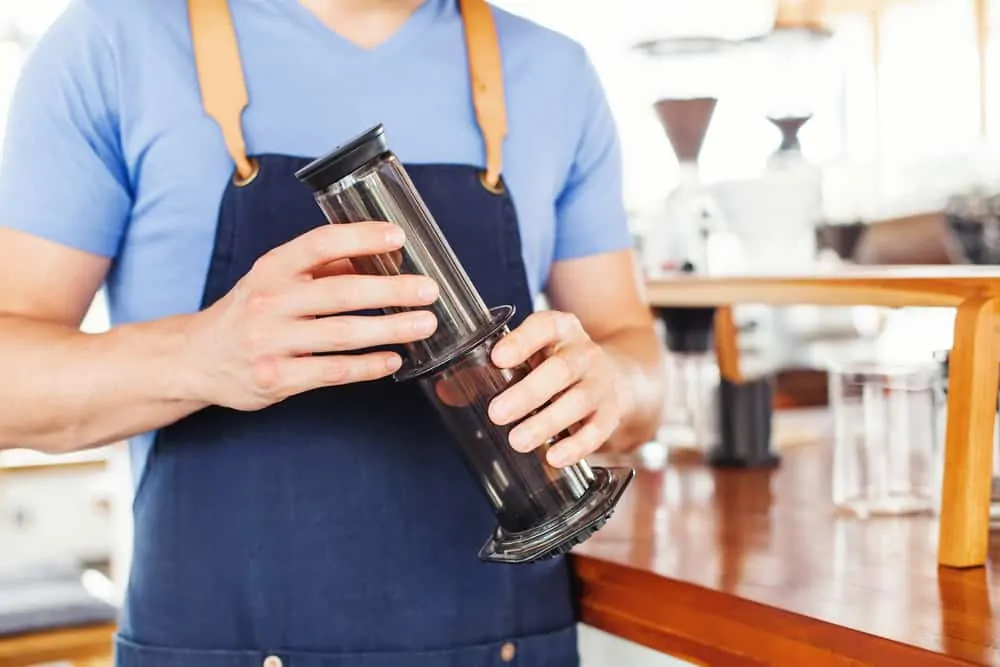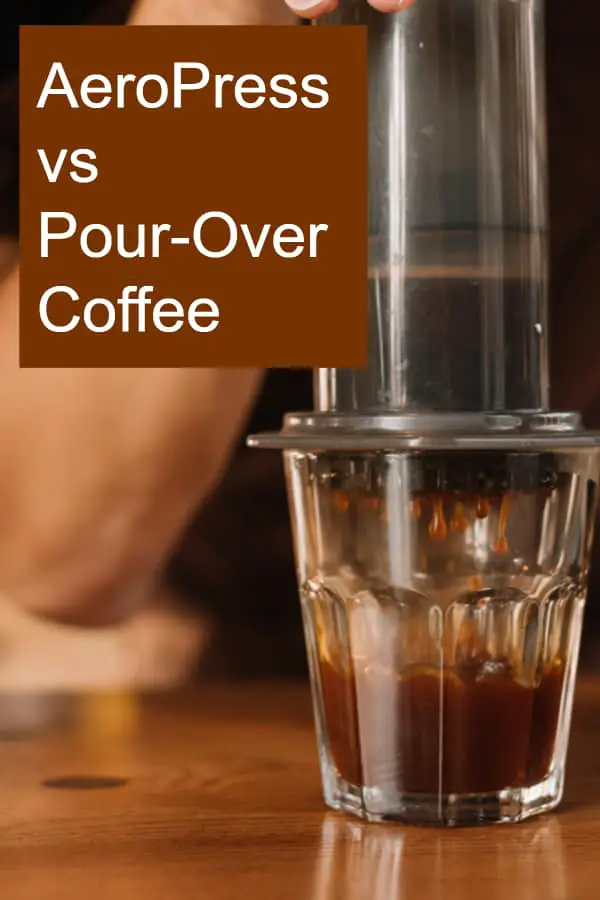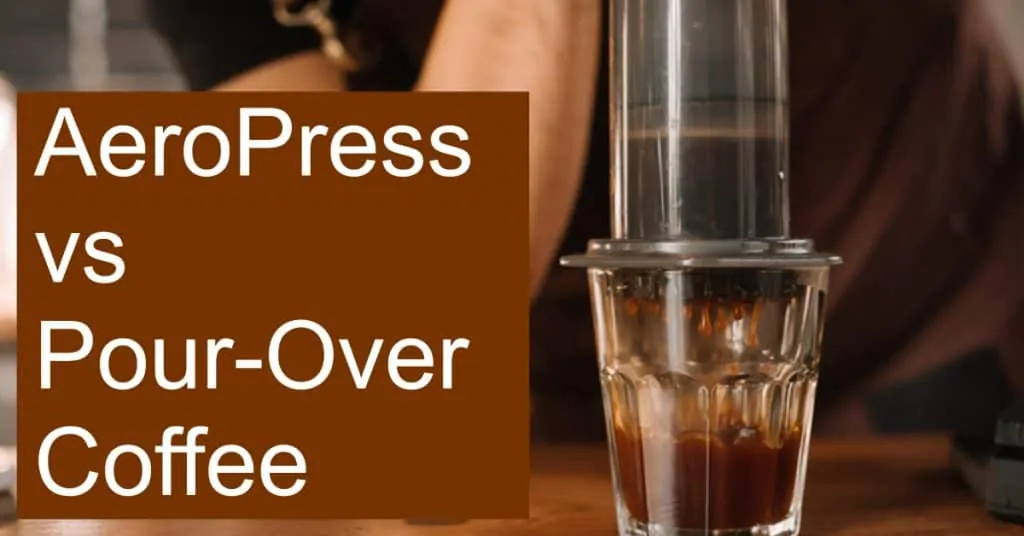We all know pour-over coffee as it’s easy to brew and you don’t need expensive machines to get your cup of Joe. But, what about an AeroPress? It’s affordable and easy to use. Is it better than pour-over? Let’s have a look when we’re comparing AeroPress vs Pour-Over Coffee!
What Is AeroPress Coffee?
The AeroPress coffee machine is a special brand of coffee makers that offers a manual way to make delicious coffee, and the process involves several different steps that allow it to make one to three cups of coffee at a time. AeroPress consists of a hollow cylinder that you insert a filter in at one end, then place it on top of a coffee mug or cup. Coffee and boiling water goes into the top, and it flows into your coffee cup to make the perfect drink.
The AeroPress coffee maker is great because you need no electricity or special power source to make the coffee, which means you can easily take it with you when you go camping or hiking. You can usually buy these kits anywhere other coffee makers are sold, and you can buy either whole kits or just replacement parts when you need them. You only need a few specialized parts to make this type of coffee, and all of those parts are included in the starter kits.

What do you need?
To make this type of coffee, you’ll need the cylinder, which is a hollow cylinder that is open on one end and has a cap on the other end. Inside the cap, you place a filter, then screw the cap back on and lay it on top of a coffee mug. You also need the plunger device to push down the coffee and water solution when the coffee is being brewed.
How does it work?
This is not a complicated device. Once you screw the filter into the cylinder, you place it on top of a coffee cup or mug with the cap and filter laying on top of the mug. Then, you pour coffee into the top of the cylinder and add boiling water to it. The coffee will start to brew in the cup, but you can speed up the process a bit by using the plunger that goes on top of the cylinder. As the coffee is brewing, you place the plunger inside the cylinder and push it down very gently as soon as there is no resistance. This tamps down the coffee and causes it to run into the mug with fewer air bubbles and makes sure all of the coffee is pushed into the mug so that nothing is left behind in the cylinder.
The tamping-down process is what a lot of people like the most about the AeroPress coffee maker. This step is necessary if you want a bold, very textured flavor from your coffee. None of the coffee grounds will enter the cup because the filter catches them.
What Is Pour Over?
When you see a pour-over coffee maker, it usually has a cone-shaped filter and not around like the others. Just like the AeroPress coffee maker, pour-over coffee pots are manual and require no electrical outlet or another power source. As the name suggests, you will be pouring water over the filter filled with coffee grounds so that the coffee can be brewed. It normally has two parts to it: a top part that holds the filter, coffee grounds, and boiling water that you pour over, and a bottom part to catch the coffee as it’s being brewed.
Unlike the AeroPress, however, pour-over coffee makers do not need a plunger to tamp down the coffee. You simply pour in the boiling water and wait for it to brew. You can also place the top section over a coffee mug or cup, but most people use both sections so they can use the bottom section as a decanter and pour coffee from there into the coffee cup. The pour-over coffee makers aren’t exactly the fastest brewers on the market, but they make a great cup of fresh coffee regardless of where you are or what time it is.
What is Pour Over Coffee – From the Basics to Brewing the Best Cup of Joe at Home!

What are the differences between Moka Pot vs Percolator Coffee?
How does it work?
You will need the cone-shaped filters for the pour-over coffee machines, and since the top section is also shaped like a cone, the filters will easily slip right in. Once the filter is in place, you simply pour some coffee grounds in and then cover them with boiling water. You have to make sure the water covers the grounds completely and then waits while the water soaks the grounds. After a minute or so, you’ll likely have to add a little more water and then wait some more. In fact, you’ll continue this process until the coffee is brewed completely.
Once the coffee is brewed, it will be in the bottom section of the coffee maker, which is essentially a carafe. At this point, you can simply pour the coffee into your cup and drink it. Some pour-over pots are made to fit directly over your coffee cup, which makes it even easier for you. But these pots are also generally designed to make up to three cups of coffee at a time, so most of them have a carafe at the bottom of the device that holds the coffee. Either way, however, a pour-over coffee pot is a great way to make a delicious cup or two of coffee without plugging anything into an electrical outlet.
What do you need?
If you’re interested in a pour-over coffee pot, the best thing to do is buy a complete kit so that you have everything you need to make your coffee. The only thing you’ll need to replace at some point are the filters, and those are both easy to find and very inexpensive. That being said, you should also take your time and explore the different types of pour-over coffee pots because there are numerous designs and sizes to choose from. Most are made to make one to three cups of coffee at a time, making them the perfect portable coffee pot for camping or any other outdoor event you might have planned.

Is AeroPress the Same as Pour Over?
While the AeroPress coffee maker and pour-over coffee pots are both manual coffee pots that you can use without the use of electricity or some other power device, that’s where the similarity ends. The AeroPress starter kit may make it look like it’s complicated to use, but it really isn’t. Yes, it has a lot of parts – more than your typical pour-over coffee pot – but that doesn’t mean it’s difficult to use. Once you learn about the cylinder, filters, and plunger, you’ll realize how easy it is to use this type of coffee pot, and it will become second nature to make yourself a cup of coffee this way.
The main difference between the AeroPress and a typical pour-over coffee pot is that the AeroPress requires the extra step of tamping down the coffee as it’s brewing. In contrast, with a pour-over coffee pot, all you do is pour the boiling water over the coffee grounds and wait. There is no tamping or pressing down on the coffee grounds as the coffee is brewing, which means pour-over pots have fewer parts and require a little less action on your part.
Does this mean that pour-over coffee pots are easier than the AeroPress pots? In a way, yes, but the fact is that both of these pots are extremely easy to use, and they produce a great cup of coffee in less time than you might think.
What Are the Differences in Taste?

Naturally, the taste you’ll experience with each of these brewing methods is going to change depending on the type of coffee you use, but regardless of which coffee you use, the tastes in both of these devices are going to be a little different from one another. By and large, the AeroPress coffee pot provides a fuller flavor that brings out every single aspect of the type of coffee you’re using. If the coffee brand you’re using has a lot of fruity or nutty flavors in it, you’re going to taste those nutty and fruity flavors to the full extent. It’s always a bold, rich flavor you’ll be enjoying when you use the AeroPress coffee pot. It’s closer to Espresso than drip coffee (drip vs percolator) so it’s a good base to make espresso beverages like an Americano.
With a pour-over coffee pot, you get to enjoy the true taste of the bean itself. Most coffee beans are either Arabica or Robusta beans, so when you use a pour-over pot, you’ll be able to enjoy the true taste of that particular type of bean. Pour-over coffee usually allows you to enjoy the bean’s full taste instead of the particular flavor the company added into the beans. It is a full flavor that people who love coffee will always appreciate, and you get to enjoy it every time you use a pour-over coffee pot.
Which One Takes Longer to Brew?
Neither the AeroPress nor the pour-over coffee pots take a particularly long time to brew, but both are, in fact, very slow. However, this is not a bad thing because slow brewing usually means a much better coffee when it comes to taste and texture. After all, the last thing in the world you want to rush through is the brewing of a good cup of coffee. That being said, it isn’t like you’ll have to wait 10 minutes just to enjoy the first cup of yummy coffee.
With the AeroPress coffee pot, you can expect to be enjoying that cup of coffee in about two minutes. Since you’re tamping down the coffee grounds as the coffee is being brewed, the process tends to go a little faster than the pour-over types of coffee pots, where you’re just consistently pouring water over the coffee grounds and waiting. It is naturally going to take a little bit longer to make coffee this way. As opposed to two minutes, you’ll likely have to wait around four minutes to enjoy your coffee when you use a pour-over coffee pot.
If you have hard water or you are using very fine coffee grounds, both of these processes may take a little longer, but again, you won’t have to wait forever just to get your coffee. The time it takes both the AeroPress and the typical pour-over type of coffee pot is still not that long, especially when you consider the ambiance of the process and what makes both of these coffee pots so special.

Final Thoughts
Both AeroPress and pour-over coffee pots are manual pots that allow you to enjoy the process of making coffee as much as you enjoy the coffee itself in the end. If you’re curious about which one of these methods is the easiest, most people find the AeroPress to be a bit easier than a pour-over coffee pot. This is because you’re using a plunger to tamp down the coffee grounds as they’re being brewed, and once you learn how to do this, it becomes a breeze to make your coffee.
With a pour-over coffee pot, the learning curve is a little bit wider because even though you’re just pouring boiling water over the coffee grounds, you have to learn exactly when to pour additional water, and the timeframe you use definitely affects the taste of the final product. It can sometimes be difficult to determine exactly when to pour additional water into the coffee pot, which means your coffee may taste a little different every time you make it.
If you love fresh coffee that is made manually, you’ll love these two types of coffee pots. If you’re deciding between the two types, the above information should help you decide which one is right for you. Both coffee pots are great for camping, backpacking, picnics, and all other outdoor events, and both types will make a great cup of coffee every time. The taste, time it takes to make the coffee, and even the price are all a little different depending on which one you choose, but you’ll certainly enjoy the coffee you get from either of these coffee pots.
Many die-hard coffee fans still prefer manual coffee pots, and neither the AeroPress nor the pour-over types of coffee pots will ever disappoint you.


